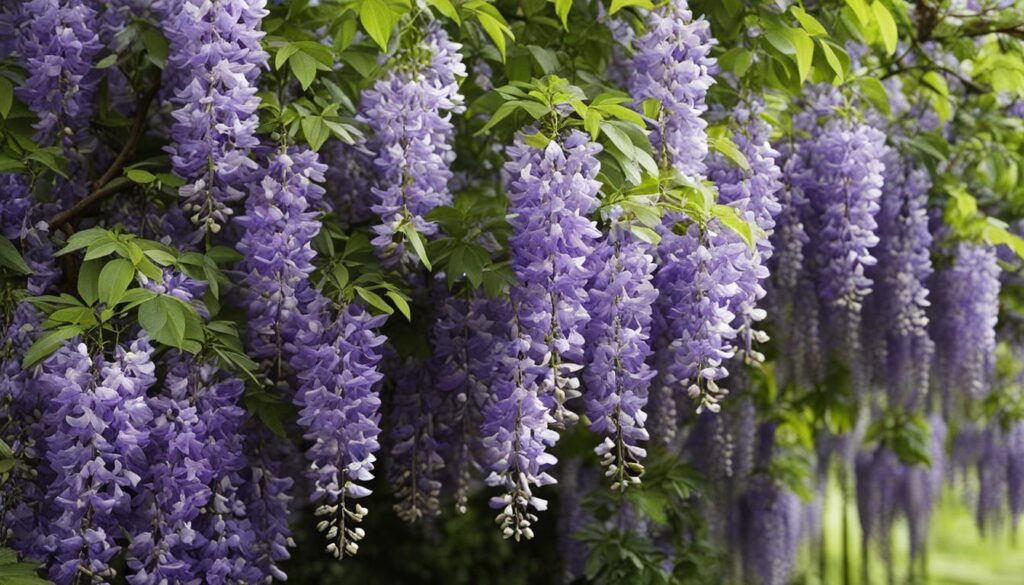
How To Grow Wisteria In The UK
Wisterias are vigorous climbers that are moderately easy to grow in the UK. They love full sun and should be planted in autumn or spring. The three most commonly grown species in the UK are Wisteria floribunda, Wisteria sinensis, and Wisteria brachybotrys. Wisterias should be planted in well-drained, fertile soil, and can be trained against walls, pergolas, or grown as a free-standing standard. Pruning should be done twice a year in July/August and January/February. Watering should be done well, especially in dry periods. Wisterias can be propagated by layering or by using cuttings or grafting. Most wisterias begin flowering within three to four years of planting.
Key Takeaways:
- Choose a suitable planting location with full sun and well-drained soil.
- Select the right wisteria variety for the UK climate, such as Wisteria floribunda, Wisteria sinensis, or Wisteria brachybotrys.
- Provide support structures like walls, pergolas, or trellises for the wisteria to climb.
- Prune wisterias in July/August and January/February to maintain shape and encourage flowering.
- Water wisterias regularly, especially during dry periods, and monitor for pests and diseases.
Choosing the Right Wisteria Variety for the UK Climate
When it comes to selecting the best wisteria varieties for the UK climate, there are three standout options: Wisteria floribunda, Wisteria sinensis, and Wisteria brachybotrys. Each variety brings its unique characteristics and visual appeal to your garden.
Wisteria floribunda is known for its stunning long flower sprays, making it an excellent choice for hanging down from a garden structure like a pergola or arch. The cascading flowers create a whimsical and magical atmosphere.

Wisteria sinensis is a popular choice as it flowers before the leaves appear. This variety is best displayed against a wall, allowing the vibrant blooms to take the spotlight and add a burst of color to your outdoor space.
Wisteria brachybotrys is characterized by its short racemes that offer a unique charm to any garden. This variety can be grown against walls or on pergolas, adding a touch of elegance and sophistication to your outdoor space.
Enhancing Wisteria Blooming in the UK
To maximize the blooming potential of your wisteria in the UK, it’s essential to provide a trellis or support structure for the plant to climb on. This not only helps guide the growth of the wisteria but also creates an enchanting visual display as the vines wind their way up the structure.
By training your wisteria along a trellis, you can create a more controlled growth pattern, preventing the climbing vines from becoming entangled or overwhelming other plants in your garden. This also allows for better airflow, reducing the risk of disease and promoting healthy blooming.
| Wisteria Variety | Best Application |
|---|---|
| Wisteria floribunda | Hanging down from garden structures like pergolas or arches |
| Wisteria sinensis | Displaying against walls for early blooming impact |
| Wisteria brachybotrys | Growing against walls or on pergolas for added elegance |
Planting and Caring for Wisteria in the UK
When it comes to planting wisteria in the UK, timing and location are key. The best time to plant wisteria is between October and April, when the plant is dormant. Choose a sunny spot with well-drained, fertile soil for optimal growth and flowering. If possible, plant wisteria on a south- or west-facing wall or pergola to maximize sunlight exposure.
Wisterias are vigorous climbers that require sturdy support structures. Install wires or a trellis system to guide the growth of the vine. Alternatively, you can train wisteria up a tree or grow it as a standard, creating a stunning focal point in your garden.
Regular watering is crucial, especially during dry periods. Adequate moisture will promote healthy growth and abundant flowering. Remember to monitor your wisteria for pests, such as scale infestation, as these can hinder the plant’s overall health and vigor. Implement effective pest control measures to prevent any infestations.
To maintain the desired shape and encourage blooming, pruning and training should be done regularly. Pruning wisterias twice a year is recommended, ideally in July/August and January/February. This will help control the plant’s size, remove dead or overcrowded branches, and stimulate flower production.
Wisteria Pest Control
Regularly inspect your wisteria for signs of pests, such as scales. These small insects can weaken the plant and hinder its growth. To control scale infestation, consider using organic insecticidal soap or oil. Apply the appropriate treatment as directed, following the manufacturer’s instructions.
Wisteria Support Structures
Providing proper support for your wisteria is crucial for its growth and longevity. Consider installing a trellis system or wires to guide the vines and prevent them from tangling or damaging nearby structures. Regularly check the support structures for stability and make any necessary adjustments.
Training Wisteria in the UK
Training wisteria is essential to control its growth and create the desired shape. Depending on your preference, you can train it against a wall, pergola, or even up a tree. Gently secure the stems to the support structure and redirect their growth as needed. Regular training will help maintain the plant’s aesthetic appeal and prevent it from becoming overly tangled or unruly.

| Common Pests | Pest Control Measures |
|---|---|
| Scale insects | Apply insecticidal soap or oil. Prune and destroy heavily infested branches. |
| Mice or rodents | Use traps or deterrents to prevent damage to the plant. |
| Pigeons or birds | Install bird netting or use reflective devices to deter birds from feeding on the flowers or foliage. |
Pruning and Propagating Wisteria
Pruning wisteria in the UK is essential for maintaining its shape and promoting flowering. Regular pruning should be done twice a year in July/August and January/February.
In summer, the excessive growth should be shortened to five to six leaves to allow the wood to ripen and improve flower bud formation.
In winter, the shoots should be further shortened to two to three buds to tidy the plant before the growing season begins.
Young wisteria should be left unpruned until they have covered the wall or structure. Wisteria can also be propagated through layering, taking cuttings, or grafting.
A comprehensive pruning schedule for wisteria in the UK:
| Month | Action |
|---|---|
| July/August | Shorten excessive growth to 5-6 leaves |
| January/February | Shorten shoots to 2-3 buds |
Pruning wisteria is crucial to maintain its shape and ensure abundant flowering. By following the recommended pruning techniques and propagating methods, you can cultivate healthy and blooming wisteria plants in the UK.
Common Problems and How to Solve Them
When growing wisteria in the UK, one of the most common problems is poor flowering. This can be attributed to several factors that may hinder the plant’s ability to produce abundant blooms. By understanding these issues and taking appropriate measures, you can ensure your wisteria thrives and graces your garden with its beautiful flowers.
1. Young Plants Taking Up to 20 Years to Flower
It’s important to note that wisterias are notorious for taking several years to mature and start flowering. Young plants often require patience, as they can take up to 20 years to reach full blooming potential. If you’re dealing with a young wisteria that hasn’t started flowering yet, don’t lose hope. With proper care and maintenance, your patience will be rewarded when it finally bursts into a breathtaking display of blossoms.
2. Pruning Technique and Timing
Pruning is essential for maintaining the health and shape of your wisteria plant. However, incorrect pruning technique and timing can hinder flowering. To ensure optimal blooming, it is recommended to prune wisteria in the late summer months (July/August) and again in winter (January/February). In summer, trim back excessive growth to five to six leaves per shoot, allowing the wood to ripen and encourage flower bud formation. In winter, further shorten the shoots to two to three buds, tidying the plant before the growing season begins.
3. Lack of Sunlight
Wisteria plants thrive in full sunlight. Insufficient sunlight can negatively impact their flowering capabilities. Ensure that your wisteria is planted in a location that receives adequate sunlight, ideally on a south- or west-facing wall or pergola. This will provide the plant with the necessary light it needs to bloom to its fullest potential.
4. Water Shortage During Critical Periods
Wisterias require generous watering, especially during critical periods such as dry spells. Lack of water can stress the plant, leading to poor blooming. Be attentive to the moisture levels of the soil and provide sufficient watering to keep the roots hydrated. However, avoid overwatering, as this can cause root rot and other issues.
5. Spring Frosts
Wisterias are susceptible to damage from spring frosts, which can harm the flower buds and hinder blooming. To protect your wisteria from frost damage, cover it with a frost cloth or horticultural fleece during cold nights or frosty periods. This will help shield the plant and preserve the flower buds.
6. Poor Soil Conditions
Wisterias prefer well-drained, fertile soil. Poor soil conditions can affect their overall health and flowering. Ensure that the soil is adequately prepared with organic matter and well-drained to avoid waterlogging. This will provide a favorable environment for your wisteria to thrive.
7. Damage by Pests
Wisterias can sometimes fall victim to pests such as pigeons or mice, which can damage the plant and hinder its growth. Implement appropriate pest control measures to keep these pests at bay and protect your wisteria. Regularly inspect the plant for any signs of pest infestation and take prompt action if necessary.
Other Problems
While the issues mentioned above are the most common, there are a few other problems that may arise when growing wisteria. These include wisteria graft failure, fungal root disease, powdery mildew infection, and scale infestation. Regular care, maintenance, and appropriate pest control measures can help prevent and address these problems, ensuring the health and vitality of your wisteria.
By being aware of these common problems and taking proactive steps to address them, you can cultivate a flourishing and vibrant wisteria in your UK garden. With the right care, your wisteria will reward you with stunning blooms and a touch of elegance.
| Common Problems | Solutions |
|---|---|
| Young Plants Taking Up to 20 Years to Flower | Be patient and provide proper care and maintenance. Young wisterias will eventually bloom with time. |
| Pruning Technique and Timing | Prune wisteria in late summer and winter using the recommended techniques to encourage flowering. |
| Lack of Sunlight | Ensure your wisteria is planted in a sunny location, preferably on a south- or west-facing wall or pergola. |
| Water Shortage During Critical Periods | Water your wisteria adequately, especially during dry spells, to prevent water stress. |
| Spring Frosts | Protect your wisteria from frost damage by covering it during cold nights or frosty periods. |
| Poor Soil Conditions | Ensure the soil is well-drained and fertile by preparing it with organic matter before planting. |
| Damage by Pests | Implement proper pest control measures to protect your wisteria from pests like pigeons or mice. |
| Other Problems | Stay vigilant for wisteria graft failure, fungal root disease, powdery mildew, and scale infestation. Address these issues with appropriate care and pest control measures. |
Conclusion
Growing wisteria in the UK can be a rewarding and beautiful addition to your garden. By following these wisteria planting tips and care guide, you can successfully grow and maintain this stunning flowering vine in the UK climate.
Firstly, choose the right wisteria variety that suits your preferences and the UK climate. Consider the popular Wisteria floribunda, Wisteria sinensis, or Wisteria brachybotrys. These varieties are well-suited for the UK weather conditions.
Secondly, provide the necessary support structures such as trellises, wires, or pergolas for your wisteria to climb on. This not only enhances its growth but also helps control its shape and maximize blooming potential.
Lastly, ensure proper pruning and maintenance. Regularly prune your wisteria in July/August and January/February to maintain its shape and promote flowering. Water it well, especially during dry periods, and monitor for pests such as scale infestation to keep your wisteria healthy and thriving.
With these wisteria planting tips and care guide, you can create a stunning display of fragrant wisteria flowers in your garden, bringing beauty and elegance to your outdoor space. Enjoy the vibrant blooms and the joy they bring each spring and summer.
FAQ
How do I grow wisteria in the UK?
To grow wisteria in the UK, plant it in well-drained, fertile soil in a sunny location. Provide support in the form of wires or trellis, and water it well, especially during dry periods. Prune and train it regularly to maintain shape and encourage flowering.
What are the best wisteria varieties for the UK climate?
The best wisteria varieties for the UK climate include Wisteria floribunda, Wisteria sinensis, and Wisteria brachybotrys. Wisteria floribunda is known for its long flower sprays and is ideal for hanging down from a garden structure like a pergola or arch. Wisteria sinensis flowers before the leaves appear and is best displayed against a wall. Wisteria brachybotrys has short racemes and can be grown against walls or on pergolas.
How should I plant and care for wisteria in the UK?
Plant wisteria between October and April in well-drained, fertile soil in a sunny location. Provide support with wires or trellis, and water it well, especially during dry periods. Control pests and diseases, and prune and train it regularly to maintain shape and promote flowering.
How should I prune and propagate wisteria?
Prune wisteria in July/August by shortening excessive growth to allow the wood to ripen. In January/February, further shorten the shoots to tidy the plant before the growing season. Propagate wisteria through layering, taking cuttings, or grafting.
What are common problems when growing wisteria in the UK?
Common problems when growing wisteria in the UK include poor flowering, graft failure, fungal root disease, powdery mildew infection, and scale infestation. These problems can be caused by various factors such as young plants taking time to flower, pruning technique and timing, lack of sunlight, water shortage, spring frosts, poor soil conditions, and damage by pests.
How can I solve common problems when growing wisteria?
To solve common problems when growing wisteria, provide proper care and maintenance, monitor for pests and diseases, and take appropriate pest control measures. Adjust pruning techniques and timing, ensure sufficient sunlight and water supply, improve soil conditions if necessary, and protect against spring frosts. Seek professional advice if needed.